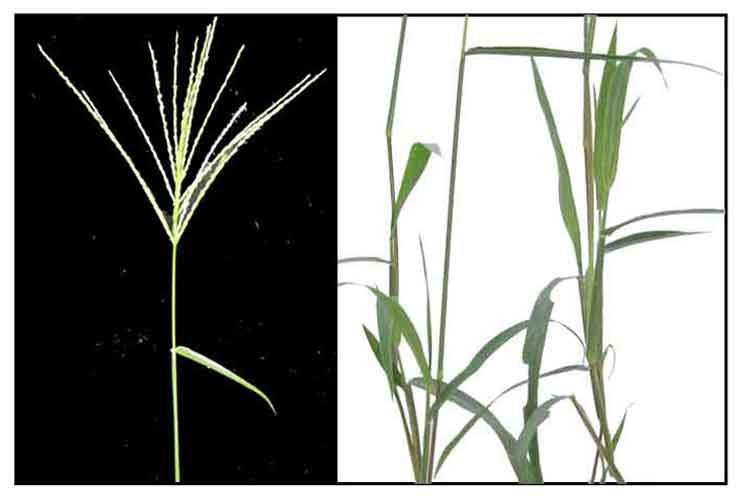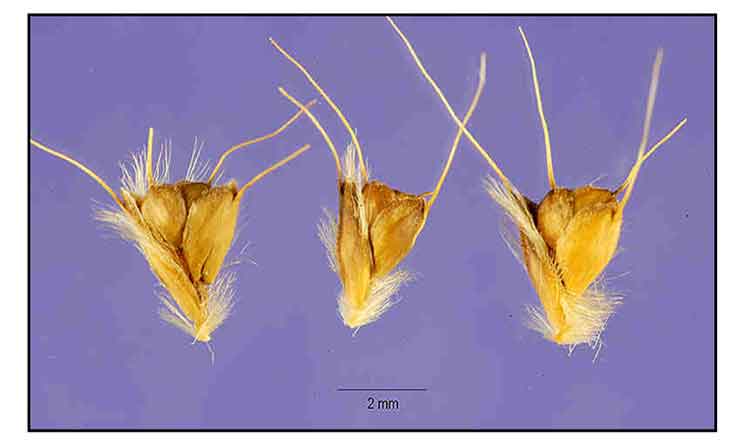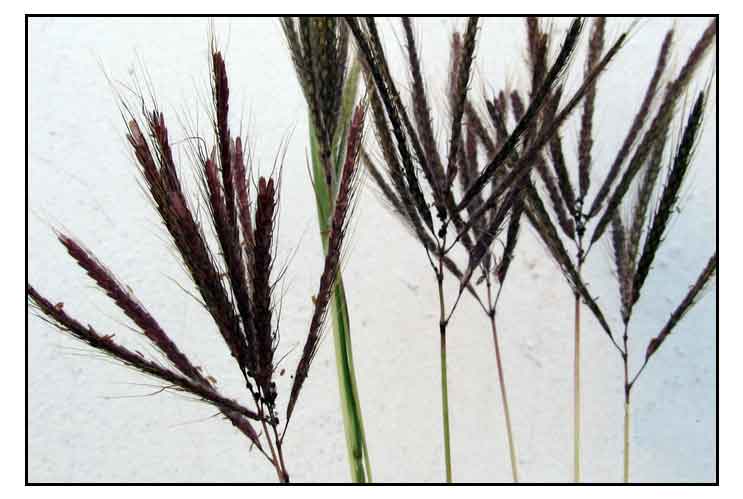
Gen info
- Chloris is a widespread genus of monophyletic grasses belonging to the family Poaceae, generally known as windmill grass or finger grass. There are 53 species currently accepted. (17)
- Chloris barbata, the swollen fingergrass or purple top chloris, is a widespread species of flowering plant in the grass family Poaceae. (18)
- Etymology: The genus Chloris was named for Chloris of Greek mythology, goddess of spring and new growth. The specific epithet barbatus means "bearded", referring to the long hairs of the 1st pair of lemma. (19)
Botany
• Korokorosan is a annual, tufted, erect grass, growing 0.5 to 1 meter high. Leaves are thin, linear-lanceolate, rounded at the base, acuminate, flat, 8 to 15 centimeters long, with a flowering stalk at the tip of its stem. Floral branches are numerous, opening from a central point suggesting the ribs of an umbrella. Florets are dense and tiny, with long purplish hair. Grains are trigonous.
• Growth form: It is an erect, annual grass, up to 50 - 90 cm tall. Foliage: Leaves are smooth and linear, reaching 10 - 20 cm long and 1 - 6 mm wide. The leaf sheaths are flatten and membraneous with a minute ligule (projection at the top of the leaf sheath). The leaves are arranged distichously (alternately in two ranks) along the culms. Stems:The culms (above-ground stems of grasses and grass-like monocots) are erect, up to 50 - 90 cm. The culms are occasionally decumbent (lying on the ground, but with the distal end upright), rooting at the nodes. Flowers: Inflorescence is a panicle of 7-17 spikes, each 4 - 7.5 cm long and 3 - 4 mm wide, with spikelets arranged in two rows. Each spikelets are tinged with purple and made of 3 - 4 florets, consisting of heavily reduced petals and sepals, anthers, and stigmas. The first lemma (the outermost of two bracts enclosing a grass floret) has a subapical tuft of long hairs. Fruit: Fruit is a caryopsis (a type of dry, indehiscent fruit, commonly known as a grain).
(Flora & Fauna Web)
 Distribution Distribution
- Native to the Philippines.
-
In and about towns and open grasslands and waste places from Luzon to Mindanao.
- Widespread species.
- Also native to Aldabra, Algeria, Andaman Is., Assam, Bangladesh, Benin, Burkina, Cambodia, Cameroon, Chad, China Southeast, Djibouti, DR Congo, Eritrea, Ethiopia, Ghana, Gulf States, India, Iran, Ivory Coast, Jawa, Kenya, Kuwait, Lesser Sunda Is., Madagascar, Malaya, Mauritania, Mauritius, Morocco, Myanmar, New Guinea, Nicobar Is., Niger, Nigeria, Oman, Pakistan, Philippines, Rodrigues, Réunion, Saudi Arabia, Seychelles, South China Sea, Sri Lanka, Sudan-South Sudan, Taiwan, Tanzania, Thailand, Togo, Vietnam, West Himalaya, Yemen. ( 6)
- It is considered an invasive weed species and is host to a number of serious agricultural pest species. ( 18)  Constituents Constituents
- Aqueous extract of leaves yielded phytosterols, flavonoids, tannins, phenols, carbohydrates, proteins and amino acids. (see study below) (3)
- Study for phytochemical constituents of roots yielded amino acids, glycosides, proteins, and carboxylic acids. (see study below) (5)
- Phytochemical screening of fresh leaves yielded coumarins+, flavonoids ++, glycosides+, phenols+, saponins+. Quantification of secondary metabolites yielded flavonoids 0.007±0.001, phenols 0.800±0.021, saponins 0.646±0.0026, and tannins 0.720±0.010. (13)
- Phytochemical screening of methanol leaf extract yielded flavonoids, glycosides, alkaloids, saponins, and triterpenoids. (see study below) (18)
- GC-MS study
of methanol extract yielded major phytochemical constituents of 2-carboxymethyl-3-methyl-cyclopentane carboxylic acid (11.57%), acetic acid,3,3,6-trimethyl-4-oxo-3,4-dihydro-2H-pyran-2-yl-ester (3.04%), ursodeoxycholic acid (33.58%), 1-octene, 2-methoxy (2.8), 2-propenimine,3-[1-cyclohexenyl]-N-cyclohexyl, N-oxide (40.4%) and 1,3,12-Nonadecetriene (7.8%). (20)
Properties
- Studies have suggested analgesic, anti-inflammatory, antibacterial, antidiabetic, antihyperlipidemic, antipyretic, anthelmintic, cytotoxic, anticancer, antiurolithiatic, phytoremediation properties.
Parts used
Leaves, roots.
Uses
Folkloric
- In the Philippines, the Y'Apayaos of Sta. Praxedes, Cagayan Province use extracts from Duukayang leaves and roots to prevent hair loss. (22)
- In India, paste of leaves applied externally for skin diseases. Leaf juice use for fever, diarrhea, and diabetes. (1)
- Leaf juice used for fever, diarrhea, and diabetes.
- In Tamil Nadu, India, leaf paste applied externally for fever and diarrhea. (11)
- In the Navapind and Shahpur Virtanin district of Sheikupura, Pakistan, used for for diabetes and skin disorders; also as fodder. (15)
- The Malayali tribes in the Kolis hills of Tamilnadu, India, leaf paste and juice used for treatment of fever, skin diseases, and diabetes. (16)
Others
- Fodder: Used as fodder when young.
- Ethnoveterinary: Used as disinfectant.
Studies
• Analgesic / Anti-Inflammatory / Toxicity Study: Study evaluated a petroleum ether extract of Chloris barbata SW for and anti-inflammatory activity in a carrageenan induced paw edema in rats and analgesic activity using tail immersion and acetic acid induced writhing in mice. Acute toxicity showed no sign of toxicity up to a dose level of 2000 mg/kbw. Results showed dose-dependent analgesic activity and dose-related inhibition of paw edema. (2)
• Antibacterial / Leaves: An in-vitro screening of leaf extracts of Chloris barbata for antimicrobial properties yielded moderate antibacterial activity against some pathogenic microorganisms when compared with standard Ciprofloxacin. (see constituents above) (3)
• Anti-Diabetic / Anti-Hyperlipidemic / Leaves: Study evaluated a methanolic extract of leaves for in-vivo anti-diabetic and anti-hyperlipidemic activities in STZ-induced diabetic rats. Results showed a significant decrease in blood glucose and significant increase in plasma insulin and liver glycogen levels in STZ induced diabetic rats, comparable to glibenclamide. Anti-hyperlipidemic activity was evidenced by decrease in serum TC, TG. LDL-C, VLDL-C with a significant increase in HDL-C. (4)
• Antibacterial / Roots: Study of powdered root material from Chloris barbata yielded bioactive constituents linked to its antibacterial activity against Staphylococcus aureus and Escherichia coli. (see constituents above) (5)
• Antipyretic / Analgesic / Leaves: Study evaluated the in vivo antipyretic and analgesic activities of ethanolic extract of C. barbata leaves in a rat model. No toxicity was observed at an oral dose of 2000 mg/kg. Results showed significant antiypretic activity in brewer's yeast induced pyretic activity and analgesic activity in tail immersion and hot plate method. The effects were comparable to paracetamol. (9)
• Anthelmintic
/ Leaves: Study evaluated the in vitro anthelmintic activity of ethanolic leaf extract of C. barbata against Indian earthworm Pheretima posthuma using three concentrations i.e., 25, 50, and 75 mg/ml. Results showed significant anthelmintic activity at higher concentrations compared to standard albendazole in terms of time of paralysis and time of death of worms. (10)
• Anti-Urolithiatic: Study evaluated crude ethanol and aqueous extracts of C. barbata for in vitro anti-urolithiatic activity. Both extracts showed maximum efficiencies in dissolution of calcium oxalate crystals, with the ethanolic extract showing more efficiency than the aqueous extract. (12)
• Antipyretic / Analgesic / Leaves: Study evaluated the in vivo anti-pyretic (brewer's yeast) and analgesic (tail immersion and hot plate methods) activities of ethanolic extract of C. barbata leaves in rats. Acute toxicity study showed no toxicity or mortality at dose of 2000 mg/kg. Results showed antipyretic and analgesic activities comparable to standard drug paracetamol. (14)
• Cytotoxicity Potential / Leaves: Study evaluated the cytotoxicity potential of Chloris barbata leaves using various invitro models. In vitro cytotoxic efficacy of Cb leaf methanolic extract was assessed with Human epidermoid larynx carcinoma (Hep2), Africa green monkey kidney norma (Vero), Dalton's Ascitic Lymphoma (DAL) cell lines using tryphan blue dye exclusion test, MTT, Sulphorodamine B (SRB), and Neutral Red Uptake (NRU) assay. Results showed the methanolic extract of C. barbata leaves to have remarkable cytotoxic potential. Further isolation of active constituents and in vivo studies are needed to establish the mechanism involved in the anticancer activity. (see constituents above) (18)
• Silver Nanoparticles / Antioxidant / Antibacterial / Leaves: Study reports on the synthesis of silver nanoparticles using leaf extract of Chloris barbata and reducing and stabilizaing agent. The NPs were studied for antimicrobial effect against S. aureus and E. coli. The synthesized AgNPs showed highly effective antioxidant activity. The NPs exhibited good homogeneity and remarkable antioxidant, antimicrobial, and anticancer properties. (21)
• Heavy Metal Phytoremediation / Risk Assessment of Forage-Cattle-Human Food System: Study evaluated the risk incidental to growth of Chloris barbata on road margins contaminated with Pb and Cd. Pot experiments showed C. barbata to be a hyperaccumulator for Cd (BCF>1, for aerial parts) and an excluder of Pb (BCF<1, for aerial parts). The plant was found to accumulate Pb in its roots with TF1. The risk assessment is significant for India, where stray grazing of cattle on road margins is common and offers a cheap source of animal protein for the economically poor. (23)
Availability
Wild-crafted. |

 Distribution
Distribution![]()




 Constituents
Constituents